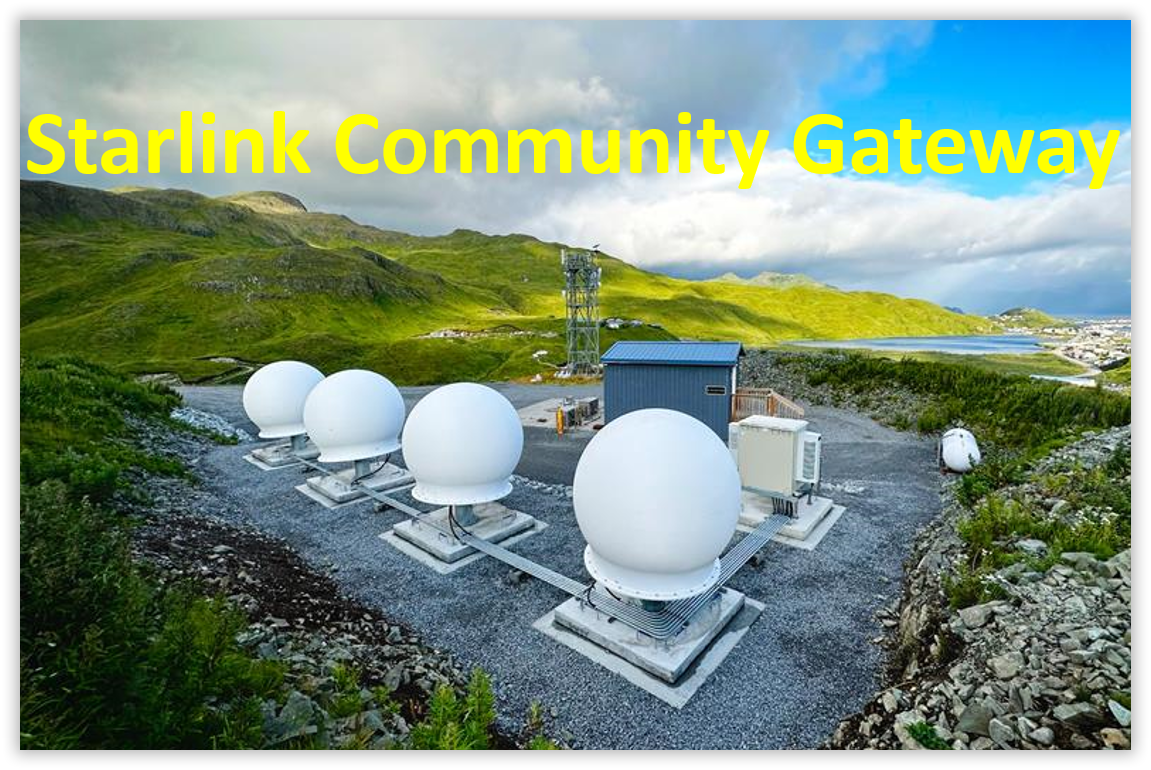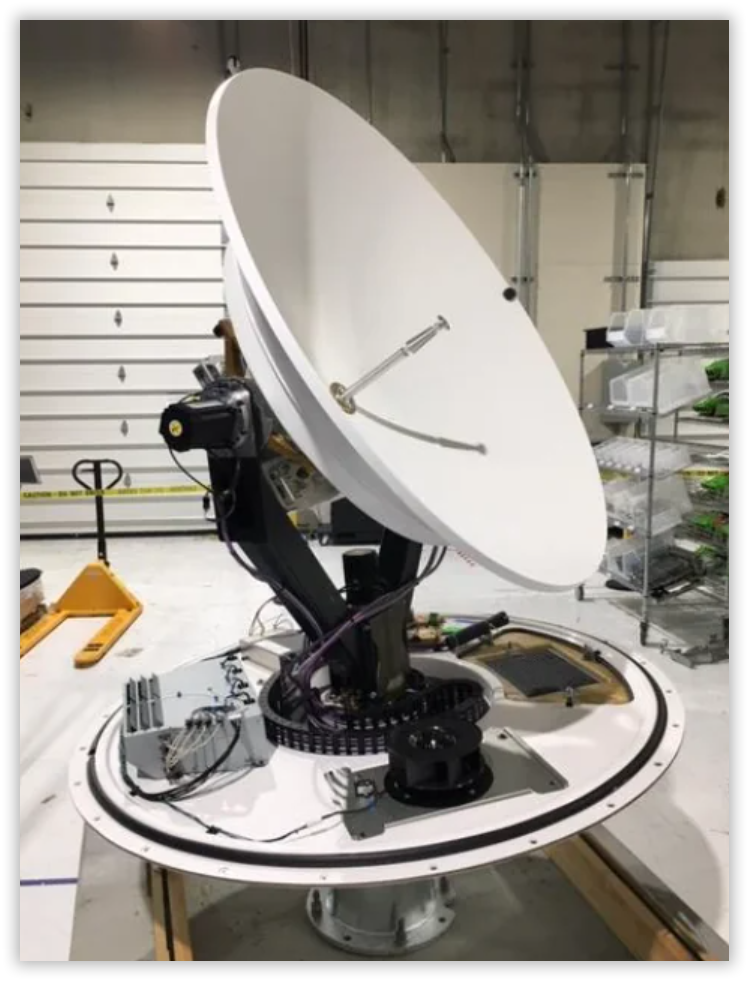
Starlink’s Community Gateway on the island of Unalaska. Source: Starlink
We’re all familiar with Starlink’s direct-to-consumer-focused low Earth orbit (LEO) satellite service, which offers global low-cost, high-speed internet access. It has quickly become one of the most disruptive innovations in the worldwide telecommunications market.
 Since launching its first batch of satellites in May 2019, Starlink has experienced phenomenal growth. Today, it is by far the largest satellite internet provider in the world regarding revenue. It commands a 35% market share, compared to the 16% held by SES Intelsat, used by Sure Falkland Islands for broadband connectivity.
Since launching its first batch of satellites in May 2019, Starlink has experienced phenomenal growth. Today, it is by far the largest satellite internet provider in the world regarding revenue. It commands a 35% market share, compared to the 16% held by SES Intelsat, used by Sure Falkland Islands for broadband connectivity.
(Image source: Alistair Schofield, LinkedIn)
However, Starlink’s Community Gateway offering differs distinctly from its residential and business services. It functions like a telecom infrastructure, delivering a high-speed data transit backhaul service to governments, enterprises, and local telecom operators.
But what exactly is backhaul? Backhaul refers to a network segment that connects edge networks, like the Falkland Islands’ terrestrial network, to the core Internet backbone, typically located in regions like the USA or Europe. Backhaul connections need to support high bandwidth and low latency. In most developed areas, this is achieved using terrestrial or undersea multi-gigabit optical fibre. However, GEO or LEO satellites are often used for backhaul in remote or underserved regions.
Sure, Falkland Islands’ Intelsat GEO satellite connection is a form of backhaul; their OneLink LEO service uses a terrestrial backhaul network via Brazil. However, both differ significantly in performance and capability from Starlink’s Community Gateway, which delivers a new level of speed and efficiency for remote backhaul applications.

Starlink Community Gateway: Who’s It Really For?
To get straight to the point, Starlink Community Gateway’s up-front one-time installation cost is $1.25m, so it is not aimed at individual consumers or small businesses. However, street prices seem to lie in the region of $900k+ after negotiation. The capacity cost is currently $75,000/month per Gbps.
Who are Starlink targeting?
-
Local telecom providers or ISPs in underserved regions: Local providers can use a Community Gateway to connect thousands of broadband customers to the Internet backbone.
-
Governments & NGOs: Especially for disaster recovery, rural education, the military, and emergency response.
-
Large enterprises such as oil rigs, mining sites, and remote factories.
 Inside the radome: (Source Reddit)
Inside the radome: (Source Reddit)
Nauru became the first South Pacific nation to sign up for Starlink’s Community Gateway service.

What Can the Community Gateway Provide?
Starlink positions the Community Gateway as a “Plug & Play” or “Fibre Alternative” for places where laying physical infrastructure is impractical or expensive. Its principal technical benefits are as follows:
-
Up to symmetrical 10 Gbps up and down (This compares to OneWeb’s 550 Mbps)
-
Low latency (under 100 ms)
-
99% uptime
-
Public IPv4 and IPv6 support
- Enterprise-grade reliability.
Starlink Gateway traffic will take multiple satellite and terrestrial paths to improve availability and performance – a single 10 Gbps VPN tunnel is not supported.

Hardware & Installation

How does Starlink achieve 10 Gbps upload/download speeds?
Each antenna communicates with a different set of satellites in parallel.
Each satellite has two types of antennas:
- Ku-band for user access (point-to-multipoint)
- Ka-band is for backhauling to gateway earth stations (point-to-point).
The Ku-band antennas generate dozens of spot beams (or “cells”) covering wide areas hundreds of miles across, distributing available spectrum across all beams. In contrast, Ka-band antennas are highly directional, each dedicated to a single gateway, with the full spectrum allocated to that single link, allowing for much higher data rates, but only to one fixed ground location. This setup allows:
-
Load balancing across antennas
-
Multipath data aggregation – similar to channel bonding in networking
-
Better redundancy and reliability
By aggregating data streams from multiple satellites at once, they effectively scale up throughput. (OneWeb’s current technology is not capable of this.)
According to a recent SpaceX application for additional FCC licences in the USA, SpaceX stated that “…earth stations will simultaneously communicate with up to eight Gen1 satellites and up to thirty-two Gen2 satellites.”
High-Bandwidth Satellite Links
Starlink satellites communicate with the ground using Ka-band frequencies, which support higher bandwidth than traditional Ku-band systems (as does OneWeb). Newer Starlink V2 satellites (especially the V2 Minis) are equipped with higher capacity payloads, boosting aggregate throughput across the network.
Phased Array Technology (on satellites)
While the Community Gateway uses traditional parabolic dishes, the Starlink satellites use phased array antennas. These allow:
-
Rapid beam steering for precise targeting
-
Dynamic bandwidth allocation to terminals like the Community Gateway
-
The ability to serve multiple ground terminals simultaneously
These antennas improve efficiency and enable satellites to support high aggregate throughput across multiple clients.
Advanced Network Routing & Traffic Engineering
Starlink uses software-defined networking (SDN) to optimise the dynamic routing of the mesh network in space.:
-
Each gateway antenna is likely assigned to different orbital planes or satellite clusters, avoiding interference and ensuring diverse routing paths.
-
Data is dynamically routed through the most optimal satellites and downlinked to Starlink’s global backbone.
- Since 2022, Starlink has used laser inter-satellite links (ISLLS), and traffic will increasingly be routed directly across satellites in orbit, reducing hops and congestion. They now have over 9,000 optical links in orbit (3 per satellite) and communicate at up to 100 Gbps with significantly reduced latencies. Signals carried using lasers in space travel about 30-40% faster than signals through fibre.
 Inter-satellite laser links Credit: CircleID
Inter-satellite laser links Credit: CircleID

Conclusions
The Starlink Community Gateway represents a fundamental shift in how remote and underserved regions can connect to the global internet. Its fibre-like performance, high throughput, and plug-and-play deployment model offer a compelling alternative to traditional terrestrial infrastructure and legacy satellite solutions.
Its design, leveraging multiple high-capacity Ka-band antennas, advanced routing intelligence, and the rapidly expanding Starlink satellite constellation, enables it to deliver up to 10 Gbps of bandwidth with enterprise-grade reliability. This positions it not just as a communications solution, but as a core piece of digital infrastructure for forward-thinking governments and telecom operators operating at the edge of the connected world.
The Community Gateway is an interesting investment for isolated locations, offering immediate capacity gains and long-term scalability to support everything from economic development to digital education and public services. While not a solution for individual users, it is an infrastructure platform with the potential to redefine what’s possible in the world’s most remote communities.
I’ve not mentioned the Falkland Islands so far. Starlink’s Community Gateway of 10 Gbps capacity far exceeds the islands’ total existing backhaul capacity. Sure Falkland Islands’ SES Intelsat’s geostationary backhaul capacity is ~2.5 Gbps divided between the 11 and 9 meter dishes and the SES/Intelsat/OneWeb LEO service has a capacity of ~550 Mbps.
If you would like to order a Starlink Community Gateway, please click here. 

Chris Gare, OpenFalklands April 2025, copyright OpenFalklands

 Since launching its first batch of satellites in May 2019, Starlink has experienced phenomenal growth. Today, it is by far the largest satellite internet provider in the world regarding revenue. It commands a 35% market share, compared to the 16% held by SES Intelsat, used by Sure Falkland Islands for broadband connectivity.
Since launching its first batch of satellites in May 2019, Starlink has experienced phenomenal growth. Today, it is by far the largest satellite internet provider in the world regarding revenue. It commands a 35% market share, compared to the 16% held by SES Intelsat, used by Sure Falkland Islands for broadband connectivity.
 Inside the radome: (Source Reddit)
Inside the radome: (Source Reddit)


 Inter-satellite laser links Credit:
Inter-satellite laser links Credit: 
Thanks Brian, for clarifying. You highlight exactly my concern for remote and isolated places with limited power supply. I imagine there would still be a need for back up, through mobile or even the ancient telephone system for example,
I’m not at all knowledgeabl about this technology, but could this be a solution to very isolated places in camp? This just a question and I would be happy to be instructed about this. I do feel very concerned about how our isolated camp places are provided for.
Hi Griz,
That installation would only work for a town like Stanley, and if there is fibre between it and mpc/mare harbour, then those places too. If fibre is run along the mpa road, then it would be possible to have a branch go to Fitzroy for example.
It doesn’t help places like Fox Bay or South Harbour, and tiny settlements like those would be better served by getting Starlink dishes. They have extremely good performance compared to “near competitors” and require significantly less power to operate. Also, you have flexibility, and can lift-n-shift it to wherever you need it to be, like the shearing-shed, for example.
Trying to upgrade all the towers to handle modern bandwidth requirements is likely to be a fool’s errand, unless Sure decides to fully embrace 5G or plans for better. Putting in the junk that they do currently – with user guides last updated almost a decade ago – does not fill me with confidence. And, yes, I’m talking March 2025!
The sentences I like to read are:
“Lasers in space travel about 30-40% faster than signals through fibre.”
and, of course
“According to a recent SpaceX application for additional FCC licences in the USA, SpaceX stated that …earth stations will simultaneously communicate with up to eight Gen1 satellites and up to thirty-two Gen2 satellites.”
I.T. folks call that ‘scalability’.